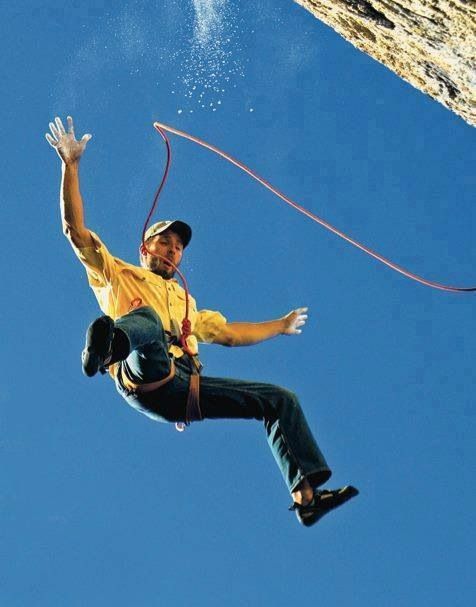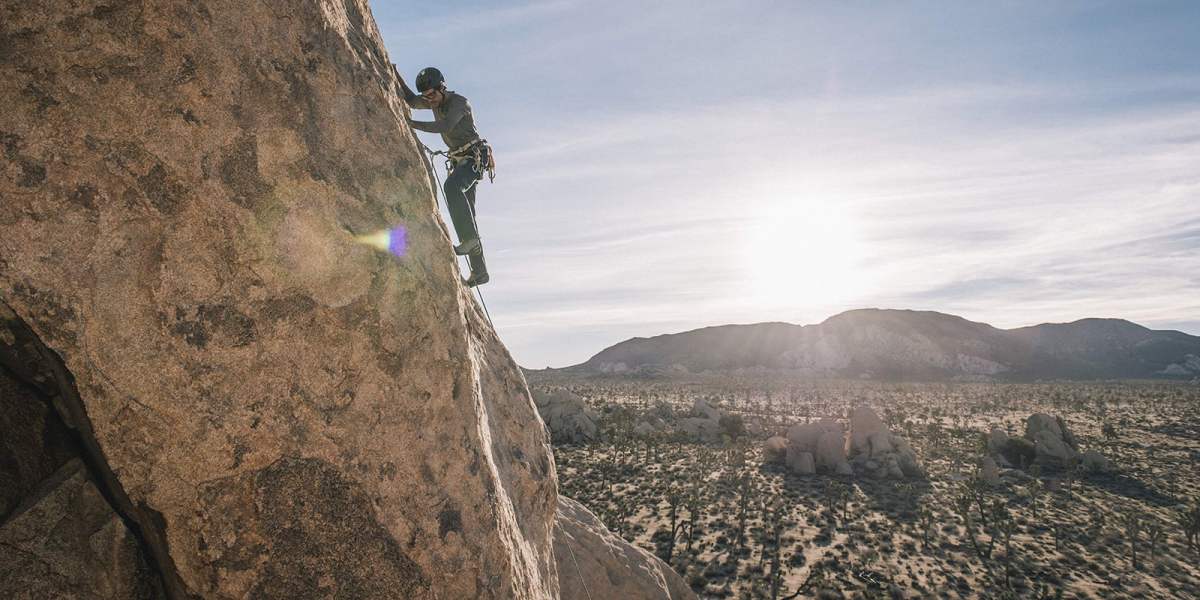At sixteen years old I found myself standing at the top of a 6-foot ladder in the middle of an airplane hanger. My instructor was at the base of the ladder, telling me to “jump”. Yes, the instruction was to jump from the top rung of a 6-foot ladder onto a concrete slab. This was the first lesson of my skydiving prep-class…. and my job was to learn how to fall. I have used the “art of falling” every day since that instruction.
As a rock climber, knowing how to fall was essential to manage potential injuries. With each climbing move , a small voice in your head was always looking for the “what if” scenario. If I use this ledge as a hand hold, what would I do if the hold gave way? Each move was a strategy, walking a tightrope between the optimism of knowing your can do it and cognitively preparing for every “what if”. There is a very special relationship between a climber and the concept of falling.
For climbers, f a l l i n g is *not* f a i l i n g. Falling simply means you have pushed yourself to the absolute limits of your body’s capabilities. There is an odd pride in pushing your body to its full limit, because this moment is the start of the journey to growing your physical, mental and spiritual self. Your mind and spirit can push you beyond your perceived physical boundaries. For climbers, falling is simply a moment to stop and ask yourself the question: Do I think I can do it? If not, how can I strengthen my resolve or find a better strategy? Am I committed to the climb? If not, muster the resolve, strategy and spirit. Then try again.
To a traditional climber, falling is a part of the climbing process. It is the understanding that, although we may not have control over WHETHER we fall, we always have a choice of HOW to fall. Knowing how to fall helps you push your capabilities to the limit, knowing that you have a plan that will still ensure your safety.

Types of Falls: What does a fall look like?
As you climb, you gauge each movement forward with the understanding that gravity exists, muscles exhaust, rocks come off the wall, rain happens, and cold weather makes it difficult for bodies to function at their peak performance. When something unforeseen happens, you can fall.
There are several types of falls in rock climbing. Some falls are close to the wall, and basically scrape your skin against the rock on the way down. Some falls swing you like a pendulum. Some falls are straight down. Some vertical falls are caught by a rope, and some are not. Sometimes you hit the ground.
Typically you choose to risk a grounding fall, only when you can see how to manage the potential fall. Managing a grounding fall is EXACTLY what I learned from jumping off the ladder in the airplane hanger. How does one hit the ground safely? Believe this or not, you can actually hit the ground safely. You can hit, tuck and roll, or even direct your fall onto something that can help break it (a bush, soft tree limbs or even your backpack). (ps.. I do not advise trying this unless you have been trained to fall).
There are a few special rules I learned in falling; I use these lessons every day in my normal (non-climbing) life.
Rule #1: Falling is not F A I L I N G. Falling = Learning
Falling is not failing, it is just not succeeding YET. When rock climbing, falling is a physical action. F a i l i n g is a state of mind. The physical action of falling simply means “I don’t know how to successfully climb this wall, YET. There is something I need to learn, and here is my opportunity to try until I learn it”. When we are children, we are not born knowing how to walk. We try. We fall. We get up. We try again. We DON’T sit and lament in judgement about who we are as people. We are simply a child who is learning to walk. Falling is a part of that journey to walking. Change your concept of falling to “simply not succeeding YET”. When you fall, look at your attempt, change something, try again. Falling is learning, and a vital part to anyone’s existence.
REAL-LIFE METAPHOR: Falling exists in the physical world. F A I L I N G exists in your mind. Choose to see falling as a moment for learning.
Rule #2: Open air gives you options
The type of fall that can ironically cause multiple injuries is “scraping down a wall”. This is typically when you do not see the fall coming, and are coming into contact with the wall the entire time. With this type of fall, you have very little control over your body, as it engages several times with the wall. Often times you end up repeatedly bouncing off the wall, with little time to move your body into a prepared state. The best remedy for this type of fall is to always push yourself away from the wall, just before you fall. This may seem counter intuitive, but it gives you the space and perspectives to SEE your choices. If all of a sudden you find yourself bouncing down a wall, you have no time to think. A free-fall gives you time. Time to see your choices. Time to gather your body and guide your choices to your safest option.
REAL-LIFE METAPHOR: When in a tight situation, step back. Give yourself time and a perspective.
Rule #3: LOOK at your landing
Whether the fall is 6 feet, 20 feet or 30 feet, you must look at where you will be landing. Look at your options. Most times the rope will catch you. LOOK at your landing. LOOK at where the rope will stop you. Closing your eyes doesn’t stop the fall. In fact, closing your eyes can limit your choices and lead to a worse outcome.
REAL-LIFE METAPHOR: With open eyes of the situation, you have the perspective that allows you to make choices.
Rule #4: Hold your body in a prepared state
Prepare your body in the air for options during the fall. When in a prepared state, you can guide your fall towards a better landing spot. You can actually use the time in the air to position your body for a safe land. A prepared state is: space between you and the wall, head-up / feet-down orientation, arms and legs spread wide, knees slightly bent.
REAL-LIFE METAPHOR: Moving yourself into a prepared state allows you to guide your life in your preferred direction. Healthy mind helps you grow and learn (growth mindset). Healthy body helps you maintain the positive energy to manage your tasks during the day. Healthy spirit helps you emotionally manage whatever the day brings you.
The more you do, the more you fail.The more you fail, the more you learn.
The more you learn, the better you get.
~~ John Maxwell, author and business leader







I blog frequently and I really appreciate your information. This great article hastruly peaked my interest.
Thanks for reaching out … as well as your interest. I am definitely writing more and more. I am open to any subjects you are interested in. let me know.
Oh man, this one hit home. I too am a climber and know exactly the art of falling. Love the metaphors.
Everything is very open with a very clear explanation of the challenges.
It was truly informative. Your site is extremely helpful.
Thank you for sharing!